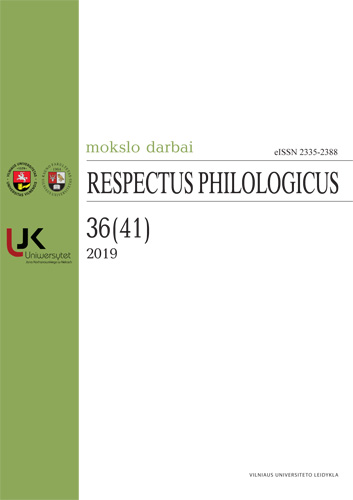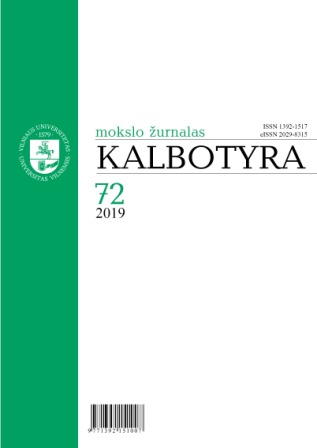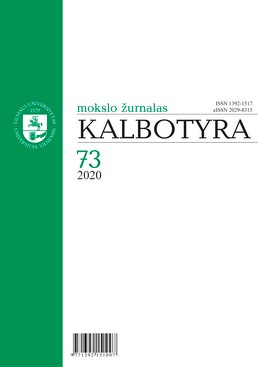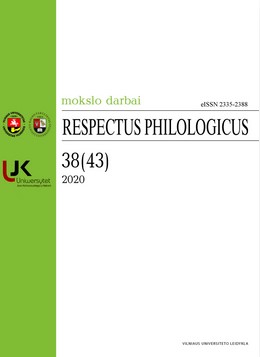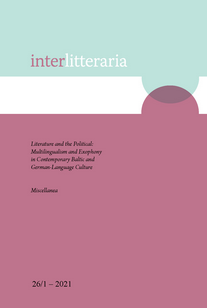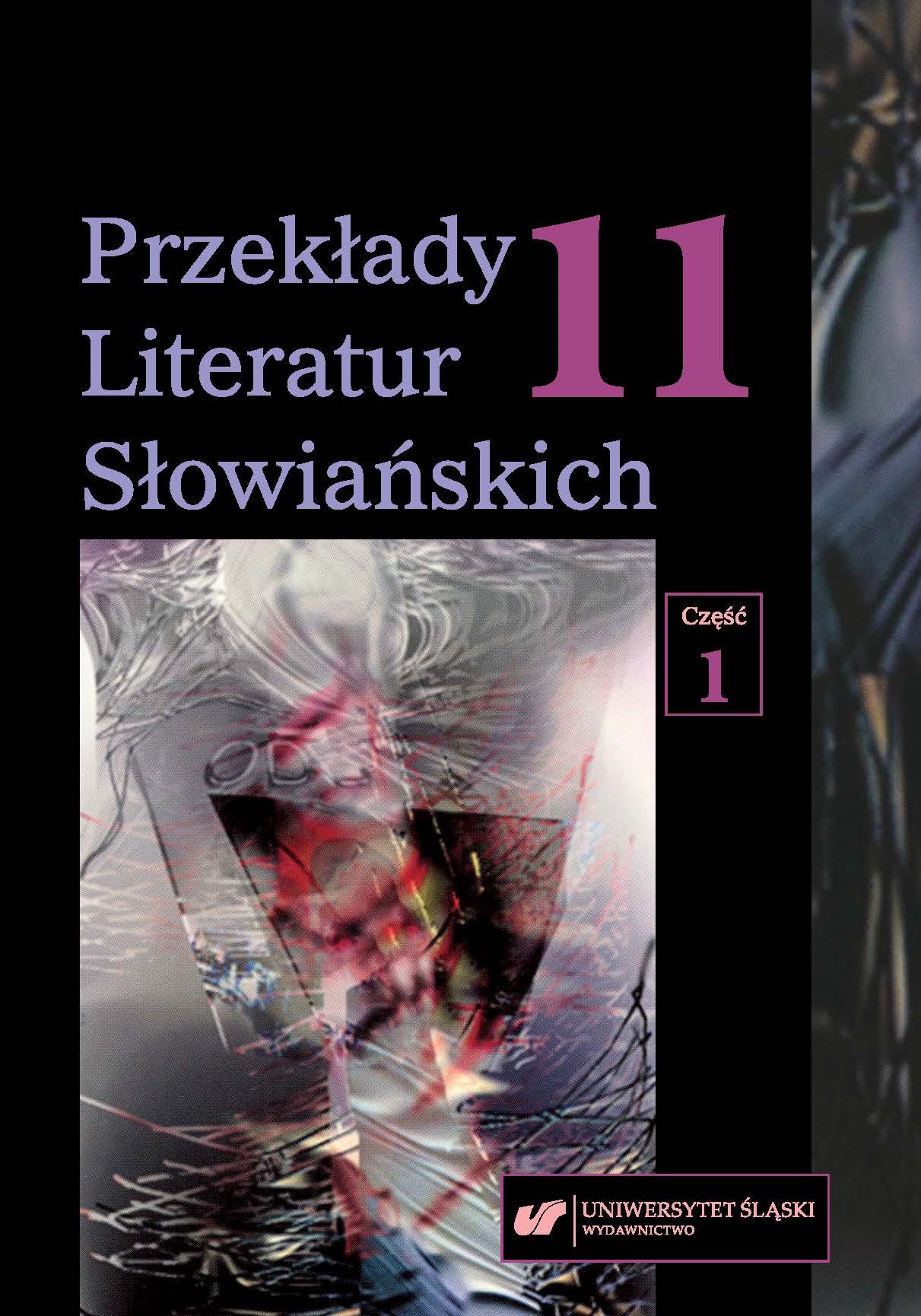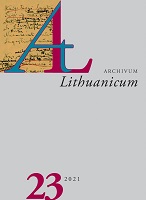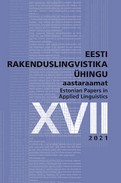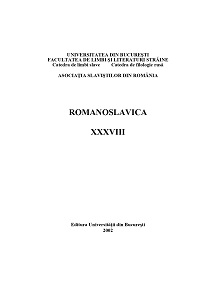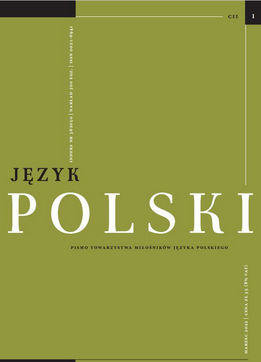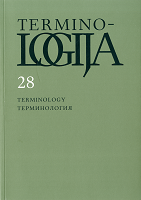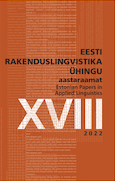Author(s): Ona Aleknavičienė / Language(s): Lithuanian
Issue: 23/2021
The article deals with the discourse pertaining to the ties between the Lithuanian language and identity in the Prussian Kingdom at the cusp of the 18th and the 19th centuries. The main sources here are four forewords to Christian Gottlieb Mielcke’s (Lith. Kristijonas Gotlybas Milkus) dictionary Littauisch-deutsches und Deutsch-littauisches Wörter-Buch (1800) as monologue texts sharing the following elements: (1) the subject of the focus (the view of the language and the nation); (2) the direct context (book publication); (3) the historical context (the political situation in the Prussian Kingdom at the cusp of the 18th and the 19th centuries); (4) the target (German reader); (5) the contents (descriptive and evaluative statements about the language and the nation). Discourse analysis is applied as a methodological access-way. In this discourse, views of the language and the nation were articulated by persons holding different positions: (1) Christian Gottlieb Mielcke, cantor at the Evangelic Lutheran Church of Pilkalnis; (2) Daniel Jenisch, philosopher and Evangelic Lutheran priest of Berlin; (3) Christoph Friedrich Heilsberg, counsellor at the House of War and Domains in Königsberg, school counsellor in Königsberg; (4) philosopher Immanuel Kant. Since Heilsberg initiated Mielcke’s foreword in April of 1799 and wrote one himself in December of 1799, brokered the deal between Mielcke and the printing house and kept correspondence with all the authors, he could have provided an impetus for writing forewords to others, and then given them the conditions to rely on the texts by one another to formulate a relevant discourse about the Lithuanian language and nation. All four forewords target the German reader. The authors of the forewords imagined the target differently, with Mielcke and Heilsberg approaching it from a rather pragmatic, Jenisch and Kant, a scientific position. Mielcke identified five target groups: priests, teachers, lawyers, translators, merchants; according to Heilsberg, these were public servants, lawyers, merchants, and teachers, hence both of them were focusing on the non-Lithuanians whose duty it was to proliferate general and religious teaching, solve legal and administrative issues, engage in trade. Jenisch and Kant primarily focused on members of the scientific and educational tribe. As representatives of different trades, the authors of the forewords also differed in their descriptions of the underlying subject of the discourse: 1. Mielcke defined the range of the Lithuanian language that had expanded in the Prussian Kingdom after the Third Partition of the Polish–Lithuanian (1795) and the need for it to be learned by non-Lithuanians, in the New Eastern Prussia post annexation in particular, to facilitate the formation of communications. In his description of the key users of the Lithuanian language, he also addressed the cultural (language, customs, traditions) and social (rustic origin) aspects of identity. 2. Jenisch considered the Lithuanian language scientifically valuable due to how old it was, its affinity with other languages, and the conservation of the characteristic features of the parent language, yet predicted its demise and raised the question of recording it for science. Jenisch approached all languages as tools for the formation and preservation of the nation’s character, and considered language and customs to be the key elements of the individuality of nations and, by the same margin, the cultural identity of Lithuanians. He saw the national Lithuanian pride and distrust towards foreigners (that could only be turned into trust when these latter spoke Lithuanian) as negative traits. Jenisch tied the disappearance of the old views and the cultural advancement with education and contacts with the western neighbouring nations; hence he approached the introduction of the German language as the right tool for the expansion of education and culture. 3. Heilsberg perceived language as a critical element of national identity, and considered phraseology a tool for the formation and upkeep of cultural identity. He highlighted that loss of language would lead to loss of virtue, a conception that was supported by the Lithuanians in their own right. According to Heilsberg, the second language-related loss would be the loss of national characteristics. By contrast to Jenisch, Heilsberg did not see any merit in introducing a single language for the whole state and even considered harmful the impact of the German language and customs on the Lithuanians, which became manifest through acculturation. Heilsberg approached the pride of the Lithuanians as a defence mechanism, and considered their modesty towards other nations – new German settlers and other foreigners in particular – as strength of character and consistency, rather than a flaw like Jenisch did. 4. Referring to Jenisch and Heilsberg, Kant stressed that efforts had to be made to preserve the unique character of the Prussian Lithuanian, and since the language was the key tool for its formation and conservation, its purity had to be protected as well. Kant did not address the issue of the survival of the language as such, the main highlight of his foreword being the conservation of the purity of language for two purposes: (1) so that the nation could develop and preserve its national identity; (2) so that the language could be used as a tool for scientific research. Contrary to Jenisch, Kant did not envision the demise of the language but rather suggested instruments to preserve the languages of the small nations, which consisted of using the language in its pure form to teach in schools and at church, and using it as such to the broadest extent possible. The essence of Kant’s foreword as a post scriptum is to underscore one important thing that had been omitted by the other authors: rather than just any kind of language, the nations per se and the science investigating the history of nations and states were concerned with language in its pure form – authentic, unique, unaffected by others. The discourse that took shape at the cusp of the 18th and the 19th centuries on the occasion of Mielcke’s dictionary and grammar being published has showed that the role of the language in the process of formation and upkeep of the nation’s identity was perceived to be unique: it was an instrument for constructing a cultural and social identity and not just a tool for communication. The Lithuanian language was also seen a symbol of the unique culture of the region, its continued existence considered to be under threat and envisioned in different scenarios. Thanks to Jenisch being able to rely on Mielcke’s foreword, Heilsberg, on the forewords by Jenisch and Mielcke, and Kant, on all three of them, the discourse is peppered with elements of peaceful dialogue and opposition, leading to a multifaceted analysis of the underlying issue that has highlighted the understanding for the ties between the language and identity at the cusp of the 18th and the 19th centuries and provided a pillar for its research later on.
More...

